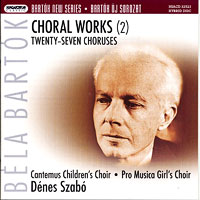Bartok's two- and three-part choruses for children's and female voices, his best-known choral cycle worldwide, appears at first sight to be distinct from the rest of his oeuvre. It is a textually inspired composition, whose arrival might seem unexpected in the period when he composed large instrumental works in the consolidated classical style, such as the String Quartet No. 5 (1934), the Music for Strings, Percussion and Celesta (1936), and the Sonata for Two Pianos and Percussion (1937). Yet it sits easily in relation to his oeuvre as a whole. � � � � � � |


